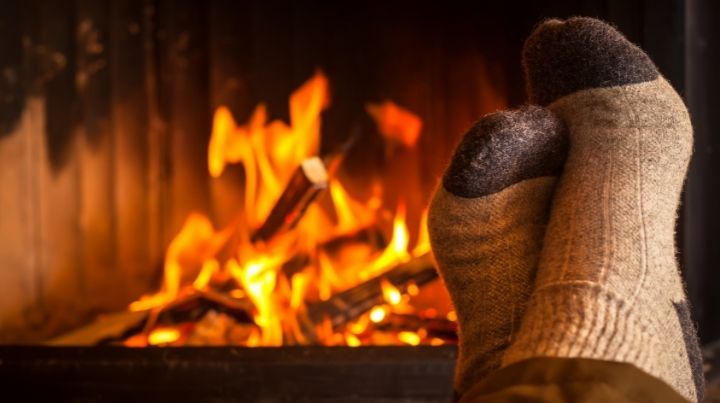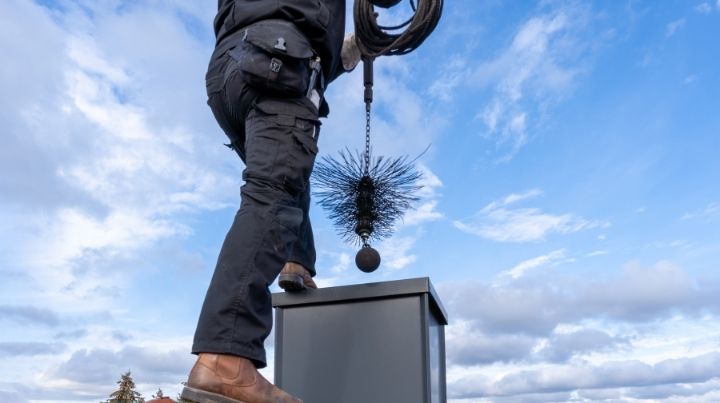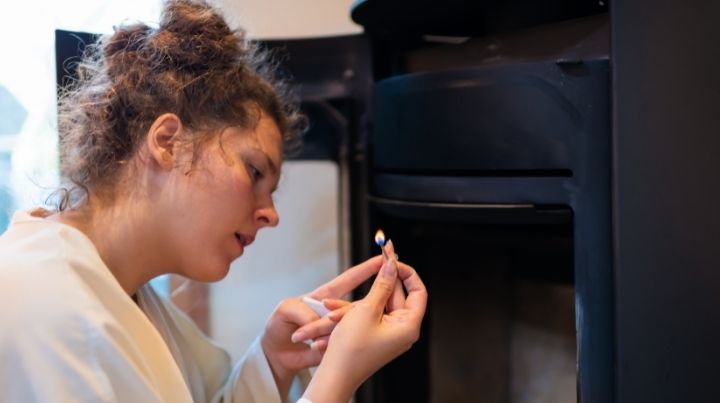Heating with Wood: Emergency Home Heating for Beginners

So, you plan on heating with wood as a backup to your oil furnace, electric heat, pellet stove, or another primary heating method?
Maybe you’ve just moved into a home with a wood-burning fireplace or wood stove.
Perhaps you are installing a wood-burning stove in your existing home.
Either way, bring on the blizzard because you’re going to be heating with wood when the power goes out!
Not so fast.
If you’ve never used a wood stove, wood furnace, or systems that are based on heating with wood, there are a few things you need to know before you get started.
First, it’s not as easy as lighting a match and throwing it into a stack of your own wood in the fireplace.
Here’s what you need to know about heating with wood safely. You don’t want to compound your emergency with a house fire or injury.
You Need Seasoned Fire Wood
In the movies, they just go out into the forest and gather up fallen branches to make a roaring fire.
Unfortunately, it just doesn’t work like that. Particularly if you are in a wet or snowy climate, the local wood you find will be too wet to burn reliably.
But that isn’t the only reason not to use wet wood.
Another reason is that it causes a lot more wood smoke as it reaches ignition temperature. The fire will have to use more of its energy to burn off the moisture in the wood, so it will also produce less hot air.
All of this causes more creosote in your chimney (we’ll talk about this more in a moment) and makes for a more difficult and inefficient wood stove heating experience.
Before the snow flies, get a load of seasoned burn wood delivered.
Wait – how do you know if it’s seasoned?
How do you know if your locally sourced wood is seasoned if you’re new to heating with wood?
“Seasoned wood will be darker in color than green wood, and may be cracking at the ends. Seasoned wood can also lighter in weight and the bark can be peeled off more easily than unseasoned wood. A moisture meter will be able to provide an accurate reading of whether firewood is fully seasoned or not.”
Alternatively, if you cut and split wood on your own, depending on the humidity in your climate, it can take anywhere from 3-12 months to properly season fire wood.
Therefore, it’s best to always work at least a year ahead.
As soon as you get your wood, stack it carefully in a place that is protected from moisture and the environment.
How Much Wood Do You Need?
When heating a small home with wood, you will need at least a cord of wood and maybe more.
A cord is defined as 128 cubic feet of wood. That’s a lot of wood!
If you are just heating one room, you may be able to get by with less, but if you are heating a whole house, you will definitely need a cord or more for your wood stove or fireplace.
Make Sure Your Chimney Is Up to Par Before Heating with Wood
Before burning wood for your first fire of the season, you should either clean your chimney yourself or have it professionally cleaned.
Failure to do so can result in a fire that starts in your chimney and burns down your entire house.
There are stacks of videos on YouTube about DIY chimney cleaning, but it’s a good idea to get a professional to perform the service if you can afford it.
Someone who spends all day every day looking at wood stoves, fireplaces, and chimneys will notice if something is awry before you will, which can prevent costly wood fire problems.
Don’t rely strictly on those chimney cleaning logs to keep your chimney clear.
Adding one to your wood fire every month or so can help to keep your chimney clear of creosote, but it won’t do a lot to remove a year’s build-up of soot and creosote.
So the creosote-clearing logs are a good addition, but not a complete solution in chimney maintenance.
Also, note that you can keep fireplace build-up down by avoiding wood from pine and other sappy trees. Avoid wood that is “sticky.”
Fire Is…Well…a Fire Hazard
Keep in mind that heating with wood can put you at risk for fire-related hazards such as burns, housefires, smoke inhalation, and carbon monoxide poisoning.
These things are all preventable and manageable with careful maintenance and handling of your wood stove or wood-burning fireplace.
- Keep children and pets away from fireplaces and wood stoves. Use a heat-resistant “kiddie corral” around the heat source to ensure they keep their distance. Be sure to keep the gate far enough away from the heat source that it does not become hot enough to be a burning risk.
- Practice fire prevention. Keep flammable items away from the fire, always have one or more fire extinguishers, and keep fire blankets nearby. Be sure that your smoke alarms are always in good working order and powered by battery, so they work when the electricity is out.
- Reduce smoke. Make sure your dampers are open before lighting a fire, use seasoned wood, and maintain your chimney to reduce the risk of smoke inhalation.
- Use a carbon monoxide detector. Always use a battery-operated carbon monoxide detector and alarm when using off-grid heat methods. Here’s a great smoke/carbon monoxide detector with lots of built-in features.
Most fire and wood heat-related injuries and accidents are reasonably easy to prevent.
Starting a Fire and Keeping It Going
I know from personal experience that lighting a fire and keeping it going for several hours are two different matters.
It’s pretty simple to light things on fire. But lighting bigger things, like logs, on fire, is an entirely different matter.
- Make sure the dampers are open. You’ll have handles or knobs on your fireplace or wood stove to adjust the flue. Check to see if it’s sucking up the smoke by lighting a rolled-up newspaper on fire and putting it underneath. The smoke should go right up the chimney. If it doesn’t, continue adjusting until it does.
- Next, set up your fireplace for fire success. Everyone has their own method. This one is mine. I like to crumple some paper on the bottom of my fireplace or wood stove. Then, on one side, I place a heavy log. I prop up one end of the log with a chunk of kindling so some oxygen can get underneath it. I’ve effectively built two sides of a triangle. Stuff more paper and some kindling under the log. Then, lay some kindling at an angle with the bottom on the bottom of the fireplace and the top on top of your log.
- Now you’re ready to light your fire. Light a rolled-up piece of paper and touch it to the papers and kindling underneath the kindling you have leaning against your log. Your goal is to set the kindling leaning against your log and under the long on fire. This may take a few attempts, especially if you’re new at this. Blow gently on your tiny flame to fuel it with oxygen.
- What to do if all efforts fail. If your fire starting efforts fail, then you may have to take more extreme measures until you get the hang of it. Use tinder such as dryer lint on top of your main log, and worst-case scenario, very, very carefully use a commercial fire-starting product. Here’s one that lights easily and stays lit for up to ten minutes, which will help give your logs time to catch on fire, too.
Don’t get discouraged if your initial efforts to start a fire fail. It’s not as easy as it seems like it would be. This is all the more reason to practice heating with wood before you must rely on heating with wood.
Extending the Heat
When the power is working, spreading the heat throughout your home is pretty easy with fans and blowers.
But when the power isn’t working, or you have a lower-tech system, you’ll need to improvise to spread the heat from your wood stove.
You can use items that absorb heat to set up a redneck radiant heat system.
Redneck Radiant Heat System:
Encircle your fireplace or wood stove with concrete blocks or large stones.
These will collect wood heating and radiate it into the room for hours. Some people even carefully relocate rocks, well-wrapped to prevent burns, into beds or cold rooms to get a little bit of heat in there.
You can also consider using these stones to try and prevent frozen pipes in extreme cold.
Conserving the Heat
Sometimes the weather is so cold that the only efficient thing to do is conserve the heat in one room.
If that’s the case, either close the doors to the room where your fireplace or wood stove is or hang curtain rods and put heavy quilts or blankets in the doorways.
Insulate any windows by rolling fabric at the bottom to prevent drafts, and pull the curtains closed unless it’s sunny enough to get some solar heat gain.
In this situation, pull mattresses into the room with the fireplace and plan on a family campout.
Do You Have Other Tips for Heating with Wood?
Do you have experience heating with wood? If so, please share your tips in the comments.
Do you have questions? Let us know, and we’ll do our best to answer. Let’s talk about heating with wood in the comments.
Related Articles
FREE Guide
Read the Best Seller
Join Mind4Survival
Stay informed by joining the Mind4Survival! 100% Secure! 0% Spam!
Affiliate Disclosure...
Mind4Survival is a free, reader-supported information resource. If you make a purchase through our link, we may, at no cost to you, receive an affiliate commission.
Do You Want To Be Ready No Matter What?

Download our free 39-page guide with interactive, 7-Day Emergency Kit Checklist and take the first step toward real preparedness.
- Know exactly where to start.
- Save time and money.
- How-to build a complete Basic Emergency Kit.
- Level up your safety and security.
Join Mind4Survival
Stay informed by joining the Mind4Survival! 100% Secure! 0% Spam!







